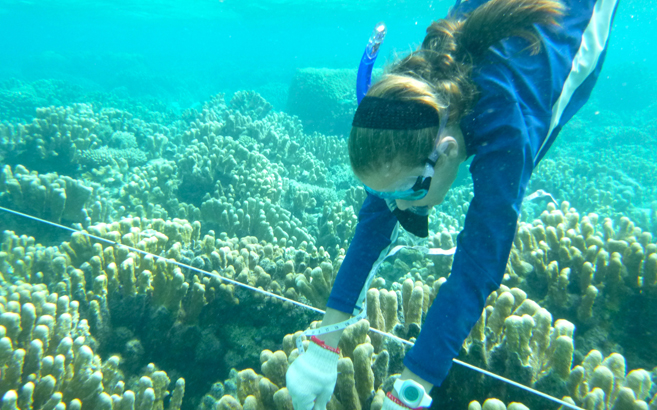An island at a cultural and biological crossroads is emerging as a place of opportunity for Northern Arizona University students who seek the fieldwork experience of a lifetime.
In the lush jungles and clear waters of Saipan, in the Northern Mariana Islands, biological and cultural diversity still thrive, although threats from development and climate change loom larger than ever.
For all those reasons, the island is an ideal location for the Field Experience in Conservation Biology, a four-month academic program being taught for the first time by NAU this winter and spring. Under the guidance of NAU faculty members Russell Benford, Nashelly Meneses and Steve Shuster, 12 students are asking important questions about local species and environmental conditions.
“This place is an exposed nerve in terms of its vulnerability to human activity and to change,” said Benford, who also works as a supervisory wildlife biologist for the Commonwealth of Northern Mariana Islands. “There is a high density of threatened and endangered species.”
While the field experience course begins with guided coursework, the students quickly transition to being “sunburned and bug bitten,” Benford said, in the pursuit of science and career building. Students who earn a biology degree, he said, often find that the real world is “entirely different” from the classroom.
“What we’re trying to do with this program is to have our conservation biology certificate holders get past that first year of eye-opening surprises,” Benford said, “such that they will be more competitive in the workplace and join it as experienced professionals.”
Besides plying the landscape and the surf on their own, students interact with local resource managers, learning what the practical work is like while advancing their knowledge in a place of rapid change.
Saipan—part of the Commonwealth of the Northern Mariana Islands, a U.S. Territory situated south of Japan and east of the Philippines—lies at a crossroads of Australasian species and in the crosshairs of economic development. “This is one of the regions of the world where a lot of economically, ecologically and politically important changes will be happening in the next century,” Benford said.
Climate change pushes the stakes even higher. Some projections show sea levels rising 1 to 2 meters in the commonwealth in the next century. “Whole coastal habitats could change or disappear,” Benford said. “We’re working hard right now to understand what we can do to intervene to mitigate the impact on human activity and wildlife.”
Benford describes the first class of students as exceptional and highly motivated, pointing out that despite challenging conditions and the far-flung locale, demand for limited slots exceeded his initial expectations.
“They are working tremendously hard every day,” Benford said. Students live in a group of secure, modern apartments during the program, balancing ocean views with hours in the field and, in spare moments, scouring the internet for data. “They need a place to put down their roots for four months and get the job done.”
One of those students, Natalie Senini, samples coral from the Saipan lagoon to study the potential effects of treated sewage water on the growth and reproduction of hard coral species. She explained that the Sadog Tasi Outfall Pipe pumps effluent into the lagoon, so her project involves sampling the diversity of nearby reefs.
“Coral is a fascinating organism that is extremely important to the health of oceans and many coastal communities,” Senini said. “This project has opened my eyes to the complexity of marine ecology and how interconnected all fields of science are.”
Senini, who said her research began “with a passion for marine ecology and a love for the ocean,” is earning a dual major in environmental science and biology with a minor in chemistry.
Another student, Rosie Alling, is determining how reef fish species will be affected by the current trend of seagrass decline around Saipan, which is attributed mostly to runoff of nitrates from the land.
From snorkeling through seagrass to analyzing satellite images of the coast, Alling works to make predictions about the populations of fish.
“A decline in reef fish species could mean trouble for the health of coral reefs and fisheries,” Alling said. “The importance of fishing both culturally and economically in Saipan is what led me to this project.”
Alling, who is earning a degree in biology with minors in chemistry and history, transferred to NAU from the University of Arizona so she could experience a hands-on approach to ecology.
“I had never planned on studying abroad because there are not very many options for someone studying ecology,” she said. “The experience of living in a place with different conservation challenges than you are used to and getting hands-on field experience is priceless.”



